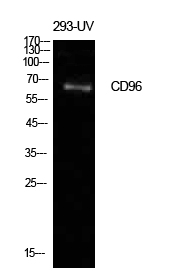CD96 Polyclonal Antibody
- Catalog No.:YT5598
- Applications:WB;ELISA
- Reactivity:Human;Rat;Mouse;
- Target:
- CD96
- Gene Name:
- CD96
- Protein Name:
- T-cell surface protein tactile
- Human Gene Id:
- 10225
- Human Swiss Prot No:
- P40200
- Mouse Swiss Prot No:
- Q3U0X8
- Immunogen:
- The antiserum was produced against synthesized peptide derived from the Internal region of human CD96. AA range:291-340
- Specificity:
- CD96 Polyclonal Antibody detects endogenous levels of CD96 protein.
- Formulation:
- Liquid in PBS containing 50% glycerol, 0.5% BSA and 0.02% sodium azide.
- Source:
- Polyclonal, Rabbit,IgG
- Dilution:
- WB 1:500 - 1:2000. ELISA: 1:10000. Not yet tested in other applications.
- Purification:
- The antibody was affinity-purified from rabbit antiserum by affinity-chromatography using epitope-specific immunogen.
- Concentration:
- 1 mg/ml
- Storage Stability:
- -15°C to -25°C/1 year(Do not lower than -25°C)
- Other Name:
- CD96;T-cell surface protein tactile;Cell surface antigen CD96;T cell-activated increased late expression protein;CD96
- Observed Band(KD):
- 65kD
- Background:
- The protein encoded by this gene belongs to the immunoglobulin superfamily. It is a type I membrane protein. The protein may play a role in the adhesive interactions of activated T and NK cells during the late phase of the immune response. It may also function in antigen presentation. Alternative splicing generates multiple transcript variants encoding distinct isoforms. [provided by RefSeq, Jan 2016],
- Function:
- developmental stage:Expressed at low levels on peripheral T-cells and is strongly up-regulated after activation, peaking 6 to 9 days after the activating stimulus.,disease:A chromosomal aberration involving CD96 is associated with C syndrome [MIM:211750]. Translocation t(3;18)(q13.13;q12.1). CD96 gene was located at the 3q13.13 breakpoint. Precise structural analysis around the breakpoint showed that the gene was disrupted by the translocation in exon 5, probably leading to premature termination or loss of expression of CD96 protein. No gene was detected at the chromosome 18 breakpoint.,disease:Defects in CD96 are a cause of C syndrome [MIM:211750]; also called Opitz trigonocephaly syndrome. This syndrome is characterized by trigonocephaly and associated anomalies, such as unusual facies, wide alveolar ridges, multiple buccal frenula, limb defects, visceral anomalies, redundant skin, psy
- Subcellular Location:
- Membrane; Single-pass type I membrane protein.
- Expression:
- Expressed on normal T-cell lines and clones, and some transformed T-cells, but no other cultured cell lines tested. It is expressed at very low levels on activated B-cells.
High-Throughput and Efficient Intracellular Delivery Method via a Vibration-Assisted Nanoneedle/Microfluidic Composite System ACS Nano Xuan Li, Yuan Ma, Yu Xue, Xuanhe Zhang, Linwen Lv, Qianghua Quan, Yiqing Chen, Guoxu Yu, Zhenwei Liang, Xinping Zhang, Ding Weng, Lei Chen, Kui Chen, Xin Han, Jiadao Wang WB Human NK-92 cell
- June 19-2018
- WESTERN IMMUNOBLOTTING PROTOCOL
- June 19-2018
- IMMUNOHISTOCHEMISTRY-PARAFFIN PROTOCOL
- June 19-2018
- IMMUNOFLUORESCENCE PROTOCOL
- September 08-2020
- FLOW-CYTOMEYRT-PROTOCOL
- May 20-2022
- Cell-Based ELISA│解您多样本WB检测之困扰
- July 13-2018
- CELL-BASED-ELISA-PROTOCOL-FOR-ACETYL-PROTEIN
- July 13-2018
- CELL-BASED-ELISA-PROTOCOL-FOR-PHOSPHO-PROTEIN
- July 13-2018
- Antibody-FAQs
- Products Images

- Western Blot analysis of 293-UV cells using CD96 Polyclonal Antibody. Antibody was diluted at 1:500. Secondary antibody(catalog#:RS0002) was diluted at 1:20000
.jpg)
- Western Blot analysis of 293-UV cells using CD96 Polyclonal Antibody diluted at 1:500. Secondary antibody(catalog#:RS0002) was diluted at 1:20000



